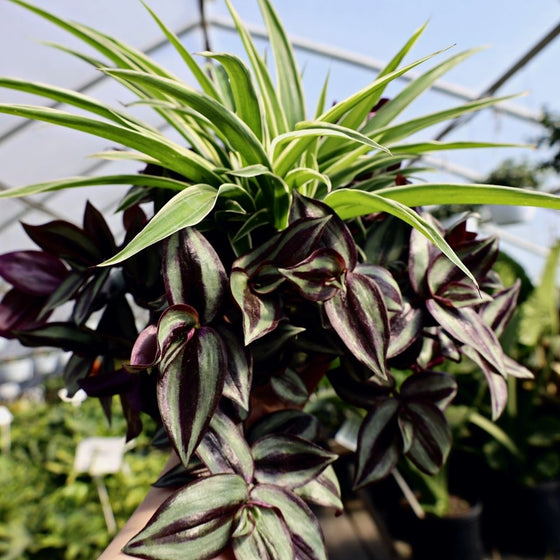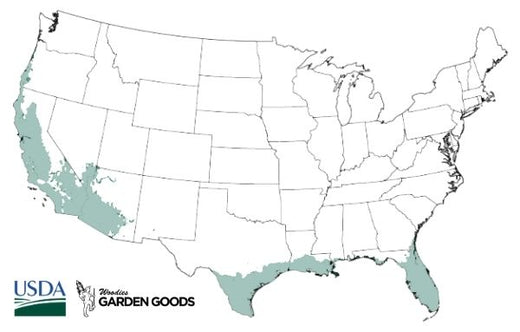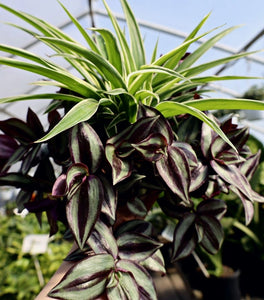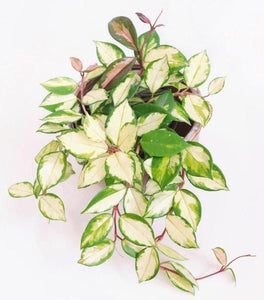
Images Depicted Range in Maturity & Container Size
Pots & Decorations Not Included Unless Otherwise Stated
Spider Plant and Wandering Jew Combo Pot for Sale Online
We took two of our best-selling hanging plants and combined them into one easy-to-care-for combination.
Spider Plants and Wandering Jew Plants were made for each other. They send out long shoots with occasional flowers on the ends. These small flower stalks of the spider plant become pups that resemble spiders and can be planted once they produce small white roots. Both plants are very easy to grow. The green and white foliage of the spider plant lightens and blends into any decor. They like fluorescent light and bright indirect light.

| Hardiness Zone: | 9-11 |
|---|---|
| Mature Height: | 10 to 12 Inches |
| Mature Width: | 12 to 18 Inches |
| Classification: | Colorful foliage |
| Sunlight: | Fluorescent to bright indirect |
| Habit: | Compact habit, insignificant flower |
| Foliage: | Green and white striped |
| Soil Condition: | Likes to dry out some between watering |
| Water Requirements: | If unsure, do not water |
| Uses: | Attractive plant to be featured or in the background of any room in the house, does well with minimal care |
How to Care for Spider Plant Wandering Jew Combo Pot
Before you buy a Spider Plant Wandering Jew Combo Pot, make sure to read about the recommended care instructions to keep this plant healthy and thriving.
What type of fertilizer should I use on my Spider Plant Wandering Jew Combo Pot?
Indoor houseplant fertilizers fall into two groups: water soluble, liquid quick release, and granular, slow release fertilizers. Jack’s Classic Indoor plant food works well as a powder, quick release fertilizer that is mixed with water to quickly provide nutrients to a plant that has been in a container for an extended time. Osmocote Indoor/Outdoor is an option as a granular, slow release fertilizer that can be applied while potting and planting. Any type of fertilizer offers nutrients that help plants with the transition to a new environment.

What type of light is best for Spider Plant Wandering Jew Combo Pot?
Both plants do best when they are planted in bright, indirect light. They can tolerate the shade and partial direct sun, but the leaves have a habit of burning when placed in aggressive, direct sunlight.
When should I water my Spider Plant Wandering Jew Combo Pot?
Spider Plant Wandering Jew Combo Pot should be watered relatively infrequently, as the plants like to dry out occasionally between watering. The easiest way to tell if a plant needs to be watered is by the weight of the container. If the container is very heavy and the foliage is upright, chances are good the plant doesn’t need water, whereas a light container and limp foliage means the plant needs some water. Sometimes, water pours out of the container without being retained by the soil. Soaking the dry soil in a small dish or saucer can be a useful way to solve this problem. It is important not to water the foliage of these plants, or to over-water them as this will lead to leaf damage or plant death. If you’re unsure, it is always better to let the plant go dry instead of drenching it with water. Moisture meters are another easy way to tell if plants need to be watered, and usually come with a guide to indicate what number or level of moisture different plants require. The tips of the leaves of the Spider Plant will start to turn brown if the plant is kept either too wet or too dry.

What are the soil and pot requirements for Spider Plant Wandering Jew Combo Pot?
If you decide to pot up your Spider Plant Wandering Jew Combo Pot into a larger pot. We suggest planting your newly purchased plant into a container 2 to 4 inches wider in diameter, and 3 to 5 inches deeper than the container it is in currently. Use a well draining potting mix, and be sure to disturb the roots when transplanting. We recommend adding a slow release fertilizer to the new potting mix. The most common cause of plant death after transplanting is planting the new plant to deep. That is why we do not recommend planting in a hole any deeper than the soil line of the plant in the pot. A good rule is that you should still be able to see the soil the plant was grown in after back-filling the container. Keep in mind that this new potting mix will retain more moisture than the previous container, so watering in the beginning should be less frequent.










